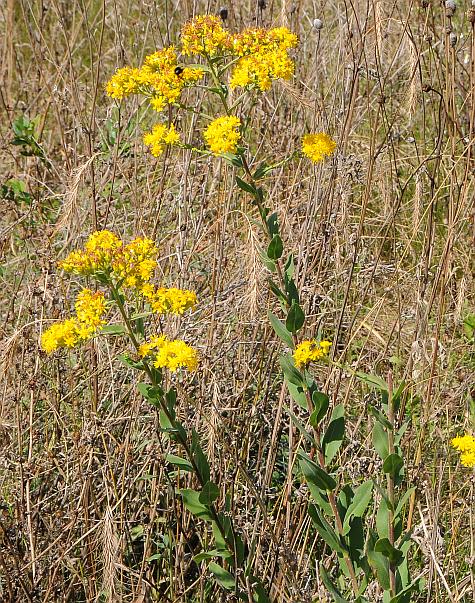Solidago rigida L.
Stiff Goldenrod

Native
CC = 5
CW = 3
MOC = 61
© SRTurner
Solidago rigida L.Stiff Goldenrod | |
 |
Native CC = 5 CW = 3 MOC = 61 |
© SRTurner |
|
Family - Asteraceae/Astereae Habit - Perennial forb with a short and branched rootstock, often producing short-creeping, stout rhizomes. Stems - Ascending to erect, to 1.5 m, sometimes multiple from the base, with several fine, longitudinal ridges or grooves, usually moderately to densely pubescent with short, curved hairs, rarely sparsely hairy to glabrous toward the base or nearly entirely glabrous below the inflorescence, not shiny.
Leaves - Alternate, basally disposed, simple, the basal and lowermost petiolate, sessile above. Offsets often present nearby. Basal and lowermost stem leaves with the blade 8-20 cm long, 1.8-4.0 cm wide, mostly 3-6 times as long as wide, oblanceolate to elliptic-obovate, ovate, or oblong-elliptic, often somewhat stiff, tapered to a long petiole at the base, angled to a usually sharply pointed tip, the margins finely scalloped or minutely and bluntly toothed, the surfaces moderately to densely pubescent with short, fine, curved hairs, somewhat roughened to the touch, the undersurface with 1 main vein, the pinnate secondary veins usually faint. Median and upper stem leaves 1.5-11.0 cm long, sessile and sometimes partially sheathing the stem, lanceolate to ovate or nearly orbicular, the margins of at least the uppermost leaves usually entire, otherwise similar to the lower stem leaves.
Inflorescence - terminal panicles, appearing flat-topped or shallowly rounded in overall outline, the heads solitary or in small clusters at the branch tips. Peduncles densely hispidulous. Inflorescence divisions subtended by small leafy bracts.
Heads - Involucre 5-9 mm long, the bracts in 3-5 unequal series. Involucral bracts mostly oblong and rounded to bluntly pointed at the appressed-ascending tip, those of the outermost series sometimes narrowly oblong and bluntly to sharply pointed at the tip, the thin, white to yellowish white margins hairy, the outer surface glabrous or finely hairy, with a green to pale green central region of varying width, the midvein slightly thickened, the 1-3 pairs of additional veins usually easily observed. Receptacle naked.
Flowers - Ray florets 6-14, pistillate, the corollas 3.0-5.5 mm long, the style purplish, glabrous, thin, 5 mm long, bifurcate, the stigmas 1 mm long, yellow. Disc florets 15-35, the corollas 4.5-6.0 mm long, the lobes 0.6-1.1 mm long, yellow. Stamens 5, adnate in the basal 1/3 of the corolla tube. Filaments glabrous, compressed, thin, glabrous, yellowish. Anthers yellow, 2.5 mm long, connate around the style, partially to wholly exserted, acute at the apices. Style exserted, purplish, bifurcate for about 1 mm. Stigmas erect. Pappus of disk and ray florets similar, 3.0-5.5 mm long, most of the bristles slightly thickened toward the tip.
Fruits - Achenes 0.8-1.7 mm long, obovoid, glabrous or sparsely hairy toward the tip. Flowering - August - October. Habitat - Prairies, loess hill prairies, savannas, glades, forest openings, fields, pastures, railroads, roadsides, open disturbed areas. Origin - Native to the U.S. Lookalikes - Other species of Solidago, such as S. petiolaris, S. buckleyi, and others. Other info. - This attractive species can be found throughout most of Missouri but is apparently absent in the southeastern corner of the state. It occurs throughout the central region of the continental U.S., most abundantly in the northern half. As goldenrods go this is one of the showier and more easily identified species. The heads and ray florets are larger than those of most other species of Solidago, and the upper leaves tend to be wide at the base and often clasp the stem. The species is much less weedy than S. altissima, and in fact makes a great garden subject. Drought tolerant and requiring little care, it is available at nurseries which carry native plants. Photographs taken in Eminence, MO., 9-21-03 (DETenaglia); also at Weldon Spring Conservation Area, St. Charles County, MO, 9-30-2012 and 10-4-2012, in Kalamazoo, Kalamazoo County, MI, 9-16-2014, and in Glade Top Trail National Scenic Byway, Ozark County, MO, 9-23-2017 (SRTurner). |